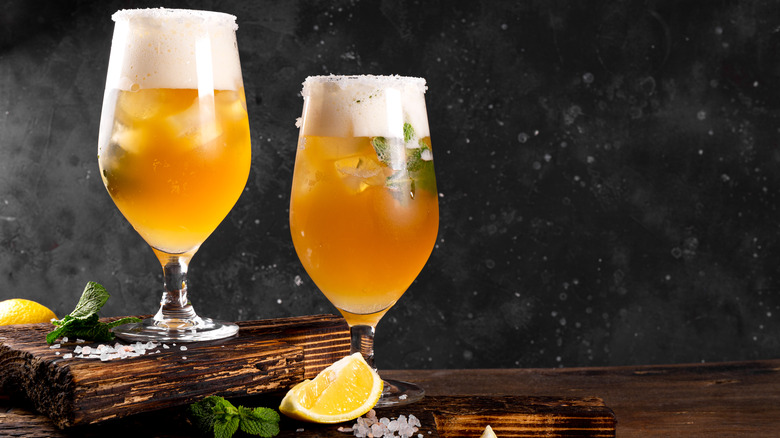The Foolproof Method To Make Cheap Beer Taste Better
Cheap beer isn't always such a bad thing. It's the first kind of beer that many of us ever sipped on, likely at a stadium with a hot dog in one hand or at tailgates on warm summer evenings. It's a college staple as well — where nights are filled with rounds of beer pong and tight budgets make anything but cheap beer a frivolous luxury.
Though light, refreshing, and dangerously easy to drink, cheap beer doesn't exactly have a good rep in the taste department. It can be bitter, sour, bland, and disappointing. But just like budget wine, the flavor of cheap beer can be improved, too. It doesn't require much: As long as you have some salt, you can make just about any beer taste better.
Besides helping to chill your beer in a flash, salt is also a fantastic flavor enhancer. It can tone down the bitterness of a cheap brew and highlight its sweet, fruity, and citrusy notes instead. Many breweries intentionally add a bit of sodium to their beer during the brewing process (the German Gose beer is particularly famous for this). It brings malted and roasted flavors to the forefront, giving the brew a fuller mouthfeel. All you have to do is add a pinch of salt to the mug or bottle you're drinking beer from, and voila! You'll find its flavor instantly elevated.
How to jazz up cheap beer with salt
Adding salt to beer is fairly straightforward, but there are a few things to keep in mind. For one, salt not only improves the flavor of beer, but it also makes carbon dioxide rise to the surface of the drink, encouraging more foam, head, and bubbles. While this can be a boon for flat brews, it can also lead to messy spills if there isn't enough space in the mug or the bottle to which you add the salt. Always drink or pour out at least a third of the beer to make space for the foam that will form once you sprinkle in the salt.
Of course, you can use any type of salt, but some are better than others. For instance, table salt often contains anti-caking agents that can leave a noticeable flavor in the beer. The same goes for fleur de sel, which can lace the drink with a hint of brininess. Instead, pick kosher or sea salt when you can or beer salts created specifically for this purpose. You could even use flavored salts spiced with lime or chili — after all, both citrus and spice can make cheap beer taste better as well. Additionally, though salt can uplift any cheap beer — IPAs, stouts, you name it — it works particularly well on light brews such as pale ale, pilsner, and lager beers.
Using salt to improve the taste of beer goes way back
Adding salt to beer is not a new concept. Germany has a history of using salt in the making of its Gose beer since as early as the 10th century when this style of beer was first invented in the country. The sodium is used to give a briny contrast to the brew's sour and spicy notes of coriander and to elevate its overall flavor. Central and South America, too, have a longstanding tradition of adding salt and lime (or citrus-flavored salt) to light beers. Some may even know this combination as a chelada cocktail — a version of the Mexican michelada that is made with the same ingredients but with the addition of hot sauces.
The practice of salting beer to improve its flavor was also popular in North America during the post-Prohibition era. Beer at the time was made from cheap ingredients, which gave it an unpleasant flavor. So drinkers soon began seasoning their brew to jazz it up: Some would add salt straight from a shaker into the beer, whereas others would rim the bottle with it and squeeze lime in. However, this practice became especially popular in states like Texas that were in close proximity to their chelada-drinking Latin neighbors. Salting beer to make its flavors pop is a popular practice in the region to this day — regardless of whether the beer is cheap or not.



